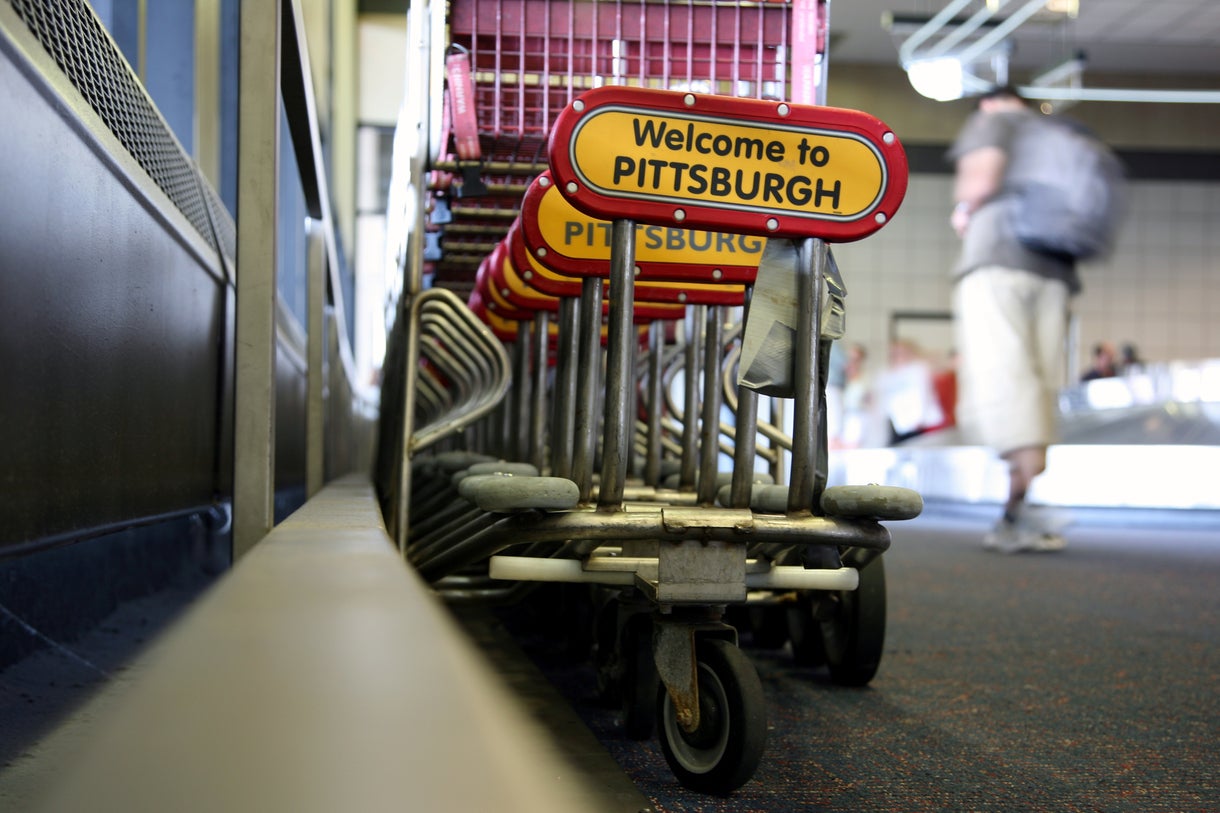Pittsburgh Airport opens its gates to non-flyers
Plane Talk: Passenger numbers are less than half what they were at PIT’s peak. Time to bring in non-passengers

Before 9/11, I spent the night at McCarran airport in Las Vegas. It was part of an exercise to see if I could survive for 24 hours with no money in the city that worships the dollar.
La$ Vega$ airport, as it sometimes appears on departure screens, is within walking distance of the big hotels and attractions on the Strip. And late at night, beyond the security check, it promised plenty of comfortable, empty seating “airside”.
The plan worked even better than expected. In the morning, I wandered landside with the first wave of arrivals, and realised that, by returning baggage carts to their appointed stables, I could claim a quarter ($0.25) a time. In 15 minutes, I had corralled enough to afford a Vegas breakfast.
In those innocent days, you needed neither a ticket nor ID to pass through the security gate. Arriving and departing passengers mingled happily with meeters and greeters, ready to welcome their loved ones at the gate.
When US aviation started up again after the terrorist attack, the relaxed approach was replaced by uncompromising, hard-line security which has now taken root with the Transportation Security Administration (TSA). Anyone who has no official business as either a passenger or an employee is excluded from departure and arrival gates.
Starting at 9am on Tuesday 5 September, though, the public can return to the melee of shops, snack bars and stressed passengers at one US airport.
Pittsburgh International says anyone will be able to wander beyond the TSA checkpoint “for shopping, dining and meeting/greeting passengers”.
No airline ticket is necessary, but you cannot just wander in; indeed, it’s more of a palaver than actually flying somewhere. In order to be allowed the dubious privilege of queuing for security, you need a driving licence or passport, and a substitute for a boarding pass. For the purposes of this pilot programme, it is named “myPITpass”.
To get the pass, you must present yourself and your ID at a special desk (if you’re tempted, it’s opposite the Allegiant Air check-in area) between 9am and 5pm. The restricted timing is not because they don’t want to pay staff to work outside office hours, but to avoid airport tourists, as I shall call them, adding to the early morning queues.
When I said “anyone” can avail themselves of this service, that’s not quite true. You will be vetted, in other words checked against a No-Fly list. (Yes, I know you’re not intending to fly anywhere, but villains might otherwise exploit a loophole in the security system.)
Assuming you have led a blameless life, and furthermore have taken care not to have a name similar to a suspect, you will be presented with a validated myPITpass.
The instructions conclude: “Go through security checkpoint observing the same rules as passengers boarding flights.”
Which means your problems are only just beginning. You must line up with all the real travellers, who are possibly going to places more exotic than Pittsburgh, and conform with all the rules that prevail for real passengers: no weapons, sharp objects, liquids over 100ml, etc.
Unless you are under 12, you will also have to remove your shoes.
The move is down to Christina Cassotis, the airport’s chief executive.
“Since I started here,” she says, “people have been asking about being able to escort loved ones to the gate or being able to shop and dine at the airport.”
And I daresay the shops and restaurants have been asking how she intends to boost business. Until American aviation started contracting after 9/11, Pittsburgh was a key hub for US Airways; passenger numbers are less than half what they were at PIT’s peak. Time to bring in non-passengers.
A pilot-of-a-pilot scheme has allowed people staying at the airport’s Hyatt hotel to venture airside. That is a smart move both for the guests, who have a wider choice of places to eat, drink and shop, and for the airport and its concessions who have more customers at what would otherwise be a quiet time of the evening.
Innovation in travel is commendable, and I welcome anything that makes air travel a more open experience. And I understand the appeal of airports as tourist attractions; growing up a couple of miles from Gatwick, outings to the terminal were a Sunday afternoon treat.
But three things puzzle me about the Pittsburgh move.
I have not noticed any shortage of dining or retail opportunities in and around the city, so I wonder how much appeal going airside at PIT will have for locals faced with paying airport parking rates and going through a thorough security check?
Will many meeters and greeters really go through all that palaver to meet friends or family a couple of minutes earlier than they would if they waited for them to emerge from Arrivals? After all, even baggage reclaim is landside for US domestic flights. I imagine only those meeting passengers who are old or frail will jump the hurdles necessary to retrieve their loved ones.
And how will real passengers react to waiting longer in line for airport tourists to be processed by security? I will certainly try out the system, but I don’t expect to be thanked by the time-pressed and stressed business travellers waiting in line behind me.
Subscribe to Independent Premium to bookmark this article
Want to bookmark your favourite articles and stories to read or reference later? Start your Independent Premium subscription today.

Join our commenting forum
Join thought-provoking conversations, follow other Independent readers and see their replies